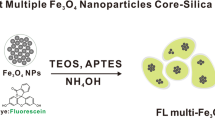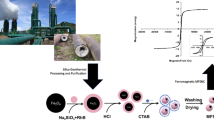Abstract
The aim of this study is to develop a new method for the preparation of Fe3O4@SiO2–An NPs from copperas. The core–shell structures of the nanoparticles and chemical composition have been confirmed by TEM, XRD and FTIR techniques. Fluorescence Enhancement of Fe3O4@SiO2–An NPs with zinc ions was investigated by fluorescence emission spectra. The results indicated that the Fe3O4 NPs with a high purity (Total Fe 72.16 %) were obtained from copperas by chemical co-precipitation method and have a uniform spherical morphology with an average diameter of about 10 nm. The Fe3O4 NPs coated with silica nanoparticles were prepared, and an attempt had been made that the Fe3O4@SiO2 NPs were modified by 3-aminopropyltriethoxysilane and 9-anthranone successively. The recommended mole ratio of ethanol to water and the content of ammonia water added were 4:1 and 25 wt% respectively, which have an obviously effect on the combination of the final well-ordered MNPs with the amino functionalities and reactant components. The functionalized Fe3O4@SiO2–An NPs have a fluorescence property and this fluorescence effect can be enhanced with the Zn2+ ions attachment. Meanwhile, the saturated magnetization of Fe3O4@SiO2–An NPs was 37.8 emug−1 at 25 °C and this fluorescent material exhibited excellent magnetic properties. A new way was therefore provided for the comprehensive utilization of the unmarketable copperas. Moreover, the functionalized Fe3O4@SiO2–An NPs have a big potential in environmental decontamination, medical technology and biological science.












Similar content being viewed by others
References
Sasikumar C, Rao DS, Srikanth S (2004) Effect of mechanical activation on the kinetics of sulfuric acid leaching of beach sand ilmenite from Orissa, India. Hydrometallurgy 75:189
Chernet T (1999) Applied mineralogical studies on Australian sand ilmenite concentrate with special reference to its behavior in the sulphate process. Miner Eng 12:485
Kanari N, Evrard O, Neveux N (2001) Recycling ferrous sulfate via super-oxidant synthesis. JOM 53:32
Liang B, Li C, Zhang CG, Zhang YK (2005) Leaching kinetics of Panzhihua ilmenite in sulfuric acid. Hydrometallurgy 76:173
Guskos N, Papadopoulos GJ, Likodimos V, Patapis SD (2002) Photoacoustic, EPR and electrical conductivity investigations of three synthetic mineral pigments: hematite, goethite and magnetite. Mater Res Bull 37:1051
Zhang W, Zhu Z, Cheng CY (2011) A literature review of titanium metallurgical processes. Hydrometallurgy 108:177
Gázqueza MJ, Bolívara JP, García-Tenoriob R, Vacaa F (2009) Physicochemical characterization of raw materials and co-products from the titanium dioxide industry. J Hazard Mater 116:1429
Mantero J, Gazquez MJ, Bolivar JP (2013) Radioactive characterization of the main materials involved in the titanium dioxide production process and their environmental radiological impact. J Environ Radioact 120:26
Liang B, Li C, Zhang C, Zhang Y (2005) Leaching kinetics of Panzhihua ilmenite insulfuric acid. Hydrometallurgy 76:173
Dimitrios F, Guillaume H (2009) Iron removal and recovery in the titanium dioxide feedstock and pigment industries. JOM 61:36
Zboril R, Mashlan M, Petridis D (2002) The role of intermediates in the process of red ferric pigment manufacture from FeSO4·7H2O. Hyperfine Interact 139:437
Xiong XH, Wang ZX, Wu FX, Li XH, Guo HJ (2013) Preparation of TiO2 from ilmenite using sulfuric acid decomposition of the titania residue combined with separation of Fe3+ with EDTA during hydrolysis. Adv Powder Technol 24:60
Xia JP, Yang CQ, Li GB, Li YP, Yue LZ, Lv JM (2005) Production of ferrous powder by oxidative roast of copperas, a byproduct of titanium pigment. Yunnan Chem Technol 32:34
Deng Y, Cai Y, Sun Z (2010) Multifunctional mesoporous composite microspheres with well-designed nanostructure: a highly integrated catalyst system. Journal of the American Chemicla Socitey 132:8466
Chaudhuri RG, Paria S (2012) Core/shell nanoparticles: classes, properties, synthesis mechanisms, characterization, and applications. Chem Rev 112:2373
Kalantari M, Kazemeini M, Tabandeha F, Arpanaei A (2012) Lipase immobilisation on magnetic silica nanocomposite particles: effects of the silica structure on properties of the immobilized enzyme. Mater Chem 22:8385
Arias JL, Reddy LH, Couvreur P (2012) Fe3O4/chitosan nanocomposite for magnetic drug targeting to cancer. Mater Chem 22:7622
Qu H, Caruntu D, Liu HX (2011) Water-dispersible iron oxide magnetic nanoparticles with versatile surface functionalities. Langmuir 27:2271
El-Gamel N, Wortmann L, Arroub K (2011) SiO2@–Fe2O3 core-shell nanoparticles for covalent immobilization and release of sparfloxacin drug. Chem Commun 47:10076
Zhang Y, Yu X, Jin Z, Jia Y, Xu W, Luo T, Zhu B, Liu J, Huang X (2011) Ultra high adsorption capacity of fried egg jellyfish-like gamma-AlOOH (Boehmite) @SiO2/Fe3O4 porous magnetic microspheres for aqueous Pb(II) removal. Mater Chem 21:16550
Zhang X, Niu H, Pan Y, Shi Y, Cai Y (2011) Modifying the surface of Fe3O4/SiO2 magnetic nanoparticles with C18/NH2 mixed group to get an efficient sorbent for anionic organic pollutants. J Colloid Interface Sci 362:107
Shi M, Liu Y, Xu M, Yang H, Wu C (2011) Core/shell Fe3O4@SiO2 nanoparticles modified with PAH as a vector for EGFP plasmid DNA delivery into HeLa cells, macromol. Bioscience 11:1563
Deng Y, Qi D, Deng C, Zhang X, Zhao D (2008) Superparamagnetic high-magnetization microspheres with an Fe3O4@SiO2 core and perpendicularly aligned mesoporous SiO2 shell for removal of microcystins. J Am Chem Soc 130:28
Kluth P, Schnohr CS, Pakarinen OH (2008) Fine structure in swift heavy ion tracks in amorphous SiO2. Phys Rev Lett 101:175503-1
Li CR, Ji AL, Gao L, Cao ZX (2009) Stressed triangular tessellations and fibonacci parastichous spirals on Ag core/SiO2 shell microstructures. Adv Mater 21:4652
Chen HM, Deng CH, Zhang X (2010) Synthesis of Fe3O4@SiO2@PMMA core-shell-shell magnetic microspheres for highly efficient enrichment of peptides and proteins for MALDI-ToF MS analysis. Angew Chem Int 49:607
Xu YH, Zhou Y, Ma WH, Wang SX (2013) A fluorescent sensor for zinc detection and removal based on core-shell functionalized Fe3O4@SiO2 nanoparticles. J Nanomater 2013:1
Zhang WL, Shi XH, Qiu L (2012) Systhesis of magnetic nano fluorescent particles Fe3O4@SiO2@An and identification of zinc ions. Chin J Spectrosc Lab 29:404
Papaphilippou P, Pourgouris A, Marinica O (2011) Fabrication and characterization of superparamagnetic and thermoresponsive hydrogels based on oleic-acid-coated Fe3O4 nanoparticles, hexa (ethylene glycol) methyl ether methacrylate and 2-(acetoacetoxy)ethyl methacrylate. J Magn Magn Mater 323:557
Bogush GH, Zukoski IV (1991) Uniform silica particle precipitation: an aggregative growth model. J Colloid Interface Sci 142:19
Song XL, Wu XL, Qu P, Wang HB, Qiu GZ (2005) Effect factor and function mechanism on dispersion and stability of SiO2 nanoparticles. Chin J Bull Chin Ceram 1:3
Liu B, Wang DP, Yao AH (2008) Preparation of core-shell SiO2/Fe3O4 nanocomposite particles by reverse microemulsion. J Chin Ceram Soc 36:569
Acknowledgments
This research project was supported by the Joint Funds of the National Natural Science Foundation of China (Grant No. u0837602) and the Yunnan Province Science Youth Experts Fund (Grant No. 2012FD012) and the authors are grateful to the Analysis and Testing Foundation of Kunming University of Science and Technology for its technical support.
Author information
Authors and Affiliations
Corresponding author
Rights and permissions
About this article
Cite this article
Lv, C., Bai, S. & Wen, S. Preparation of novel magnetic fluorescent microspheres from copperas and fluorescence enhancement with zinc ions. J Sol-Gel Sci Technol 69, 520–527 (2014). https://doi.org/10.1007/s10971-013-3252-x
Received:
Accepted:
Published:
Issue Date:
DOI: https://doi.org/10.1007/s10971-013-3252-x




